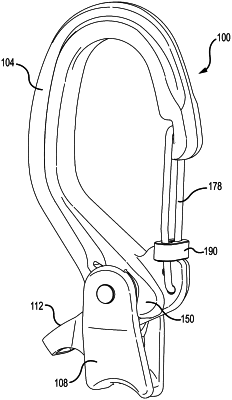| CPC F16G 11/106 (2013.01) | 6 Claims |

|
1. A rope restraining device, comprising:
a hook adapted for interconnection to an anchor;
a cradle rotatably interconnected to the hook, the hook comprising a first side wall and a second side wall that are interconnected by a bottom wall, the first side wall and second side wall comprising a taper near the bottom wall, wherein:
the bottom wall in a lateral direction between the first side wall and the second side wall has a cylindrical profile defined by a linear cross section, and
the bottom wall is an axial direction extending from a proximal end of the cradle to a distal end of the cradle has an arcuate profile relative that extends from a bottom surface of the cradle, wherein the arcuate profile relative to the bottom surface, and wherein portions of the first side wall and the second side wall bound the arcuate profile;
a cam lever positioned within the cradle and configured to rotate relative to the cradle, the cam lever having a grip geometry comprised of a plurality of teeth that faces the arcuate profile, the grip geometry having a first lateral width at a proximal end that and a second lateral width at a distal end that is less than the width of the first lateral width;
wherein the distal end of the cam lever is biased toward the distal end of the cradle; and
wherein rotation of the cam lever separating the distal end of the cam lever from the distal end of the cradle creates an opening between the grip geometry and the bottom wall of the cradle that is adapted to receive ropes of more than one diameter; and
wherein rotation of the cam lever in an operation of the distal end of the cam lever toward the distal end of the cradle decreases the size of the opening, and prevents withdrawal of the rope from the cradle in a direction that generally corresponds with the proximal end of the cradle.
|